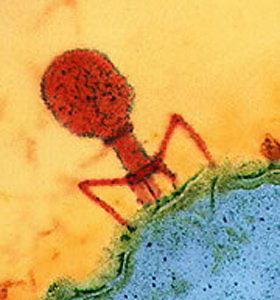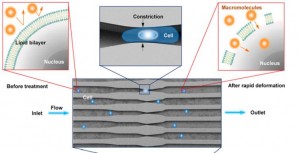Happy Fun Science FRIEDay!!
This week we bring you work from researchers at the Massachusetts Institute of Technology (MIT), where they discovered a new method to “hijack” cells. Think about it, if we could make our own cells do our bidding, we could reprogram them to do all sorts of wonderful things for us, such as manufacture insulin, attack tumors, etc. But hijacking a cell is no easy venture. In nature viruses can be quite efficient at hijacking cells, and because of this current methods employed by researchers to hijack cells entails penetrating the cell’s wall with a virus. The biggest issue with this method is that it tends to inflict permanent damage on cell.

In 2009 MIT chemical engineer Armon Sharei, and colleagues, discovered by accident another method to hijack cells. They were playing around with a new method of implanting cells with large molecules and nanomaterials using a microscopic water gun. Basically they were trying to insert particles inside of a cell that would alter the cell’s behavior but also not destroy the cell in the process. Sharei noticed that when the cells were shot with water some of them became momentarily misshapen, and while they were material was getting inside! What was occurring was that when pressure was exerted on the cells, small holes formed in the cell membrane allowing for the transmission of particles inside the cell.

(Photo credit: Sharei et al. 2013, PNAS)
The water gun idea was a bit crude and Sharei worked with colleagues to refine the processes. In the end they developed a silicon-and-glass microchip etched with channels through which cells flow. As the cells flow through, the channels gradually get narrower, until the gap tapers into a space slimmer than the cells themselves. As the squeezed cells force their way through, temporary holes form in the cell membrane. The tiny holes are wide enough to let in a variety of behavior-altering agents, and apparently this technique even works on stem and immune cells, which are normally too sensitive to be manipulated using previous methods.
Since this initial discovery Sharei and colleagues have produced 16 different chips with channel arrays designed to squeeze different cells. Their chip arrays can process 500,000 cells a second, and Sharei et al. has started a company to commercialize the technology called SQZ Biotech.
You can read the original article published in the Proceedings of the National Academy of Sciences or watch the informative video interactive publication at JOVE.
Happy FSF! 🙂